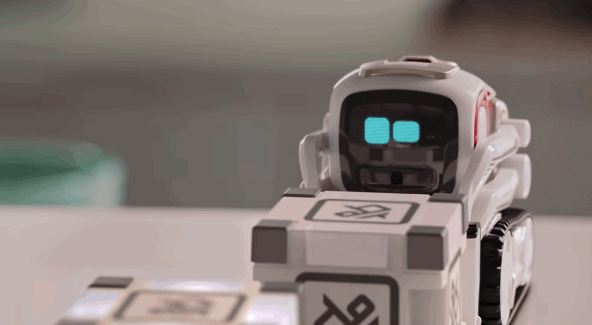I made a new friend last week. Though I’ve only known him a short while, I’ve already learned that he’s a sore loser, he’s easily confused, and he gets frustrated when he’s pushed out of his comfort zone.
I should also add that my new companion isn’t human. He’s called Cozmo, a new artificially intelligent toy from Anki, the company behind the Overdrive self-driving race cars. That Cozmo looks like a pint-sized version of Wall-E should come as no surprise, given that some of its creators come from animation firms like Pixar and DreamWorks. It’s launching Oct. 16 for about $180, just in time for the holidays.
What makes Cozmo different than the array of other so-called “smart toys” out there? Thanks to a combination of artificial intelligence and computer sensors, Cozmo is able to react to what’s happening around him, recognize human faces, and play quirky mini-games. His actions aren’t pre-programmed, meaning he’ll react differently to the same stimuli at different times. When you pick him up, sometimes he’ll furrow his brows and squawk angrily, while other times he’s happy to be coddled. That unpredictability makes him feel a little bit like a real pet — perhaps a cat moreso than a dog.
That Cozmo can “see” his surroundings means he knows where to look when he wants to play a game, he can swerve around obstacles, and he can stop moving to avoid falling off a table. In one instance, Cozmo even managed to stop himself as his two front wheels crossed over the edge of my desk. With his front half of his body hanging off the ledge, he let out a few adorable worried squeaks and began to back up.
After setting up Cozmo via his corresponding smartphone app, he can recognize his owner’s face, reciting his or her name when spotting them. This worked well the first time I used Cozmo, but he didn’t remember my name or face during other play sessions, unfortunately (An Anki representative said this may have been because the light in my apartment wasn’t bright enough). Names are the only words Cozmo can actually speak. He otherwise communicates through a series of mechanical beeps, boops, squeaks, and chirps, like Star Wars’ R2-D2 or BB-8. He can also ask you to play games with him through his smartphone app.
It’s uncanny how well Cozmo can communicate without words. I thought the toy’s lack of voice controls would seriously hinder the experience. But having his own robotic language makes communicating with him more like playing with a pet. (Anki plans to add voice interactions to Cozmo in the future.)
Cozmo can play a few games with an accompanying set of blocks, but it’s really the way he expresses himself that makes him so much fun to play with. It’s remarkable how lifelike he can be. His eyes squint, widen, and contort to reflect his mood, further expressed through cheerful peeps or grumpy groans. When he wins a game, sometimes he’ll giggle and do a little victory dance. When he loses, his eyes droop, and sometimes he’ll slam his forklift arms in frustration. Anki says the more often you interact with Cozmo, the more his personally and preferences will change over time. (If you often beat him at a certain game, for instance, he may be reluctant to play that game with you.)

Cozmo has two games out of the box: Quick Tap and Keepaway. In Quick Tap, the player must beat Cozmo to tapping the cube sitting in front of them when both blocks glow the same color at the same time. Keepaway requires the player to push a block close to Cozmo and withdraw it before he’s able to tap it. Both games are amusing and simple, but I’m not convinced they’re engaging enough to make playing with Cozmo engaging enough to hold most kids’ attention.
Still, Anki has also done a good job at making these games re-playable by adding different challenges. If you’ve already successfully beaten Cozmo at Keepaway, the app may challenge you to win a game when the score is tied four to four. Completing these tasks helps you gain imaginary in-app currency that can be used to unlock new games and abilities. What’s more exciting, though, is that Anki is opening up Cozmo’s software to third-party developers, meaning anyone will be able to create games for Cozmo. If developers take to the platform, that could result in lots of fun new games and other applications.
Cozmo is an ambitious attempt to bridge the gap between video games and real-world toys, an increasingly popular phenomenon among toymakers (the so-called “toys-to-life” market is a billion-dollar enterprise). Indeed, Cozmo’s intelligence and endearing demeanor make him truly feel like a toy come to life. That said, Cozmo needs more games and experiences to make it worth the $180 price tag. Watching Cozmo discover the world around him and interacting with him is delightful, but that might not be enough to keep kids engaged in the iPad era. At this point, buying the Cozmo is an act of faith that more features, and more fun, are on the way. Buy here
More Must-Reads from TIME
- Inside Elon Musk’s War on Washington
- Meet the 2025 Women of the Year
- The Harsh Truth About Disability Inclusion
- Why Do More Young Adults Have Cancer?
- Colman Domingo Leads With Radical Love
- How to Get Better at Doing Things Alone
- Cecily Strong on Goober the Clown
- Column: The Rise of America’s Broligarchy
Contact us at letters@time.com